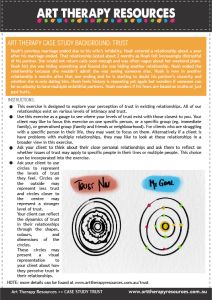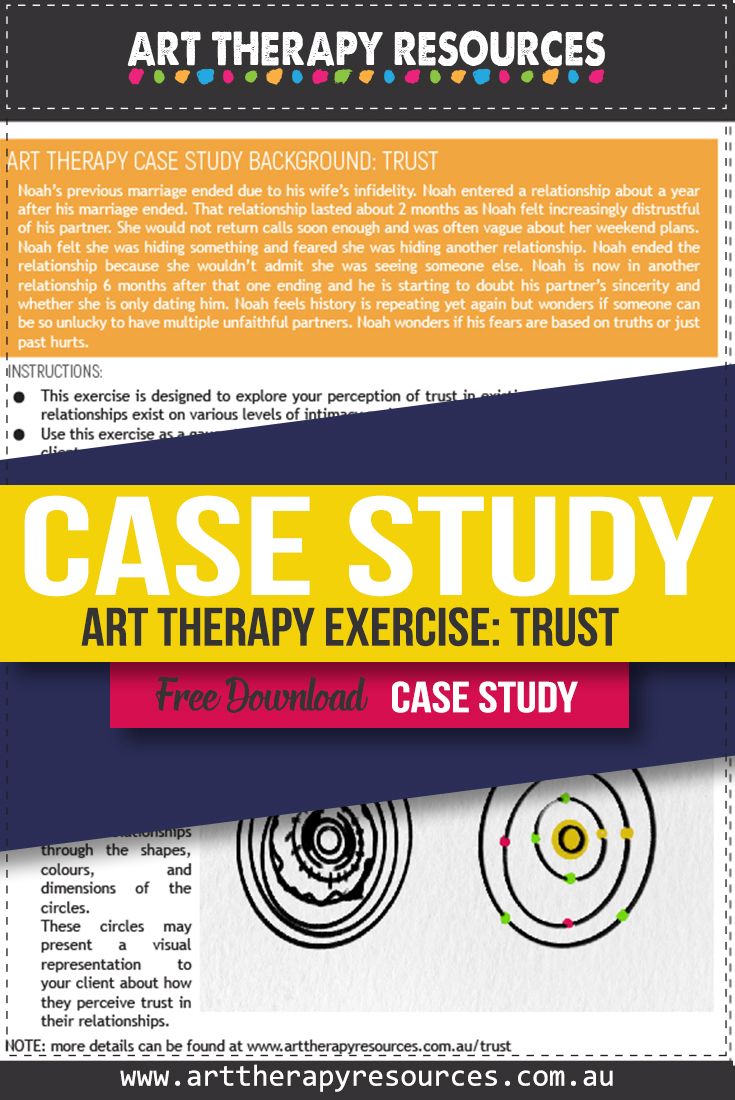THIS POST INCLUDES:
- Art Therapy and Trust
- About the Client
- Art Therapy Exercise
- Client Insight and Outcomes
- Disclaimer
- FREE DOWNLOAD Art Therapy Exercise
ART THERAPY AND TRUST
Trust is a vital component of any secure relationship. ‘Trust issues’ is a colloquial term that stems from a lack of trust present in interpersonal relationships. We all carry a certain amount of distrust as we attempt to navigate uncertain situations with the view of seeking honest and truthful interactions.
However, for some people, distrust is a default viewpoint applied to almost any situation regardless of any uncertainty. This ongoing lack of trust begins to create problems within relationships.
There is a variety of reasons why someone may experience trust issues. For most of us, past negative experiences in significant relationships can influence the way we perceive future relationships. This is particularly relevant in cases of infidelity where trust broken between a spouse or partner relationship can significantly impact both the current relationship as well as future relationships.
Trust issues can also stem from attachment issues that an individual may have experienced in childhood. This also incorporates experiences of abandonment in childhood where the child relies on the parent or caregiver to provide safety, security, and a healthy form of relationship forming. If these early relationships are damaged, this can have a significant impact on the outcomes in future relationships where potential abandonment may occur.
Trust issues can also result from traumatic experiences. For example, those who have been a victim of crime, physical assault, or other traumatic events may build protective mechanisms that appear as distrust.
The relationships that trust is most valued include:
- Romantic
- Parental (both directions)
- Friendships
Other relationships may also carry the responsibility of fostering trust, such as work relationships, mentor relationships, teachers etc, however, breach of trust in these relationships is often easier to repair compared to the three most significant relationships of romantic, parental, and friendship.
Individuals can experience debilitating levels of distrust as a symptom of disorders such as schizophrenia which creates delusions, hallucinations, and paranoia. This blog post does not attempt to cover these experiences.
CHARACTERISTICS OF LACK OF TRUST
There are common behaviours that can indicate a lack of trust. These include:
- Monitoring the behaviour of others
- Testing the loyalty of others
- Suspicion
- Jealousy – can involve jealous thoughts, emotions, and behaviours
- Extensive questioning of other’s motives and movements
- Extensive fact checking to ensure information is true and accurate
- Avoidance of emotional connections for fear of getting hurt
- Emotional distancing to avoid getting hurt
- Avoiding intimacy
HOW ART THERAPY CAN HELP WITH TRUST
Art therapy can play an integral role in helping a client explore their beliefs around trust and how this presents in their current relationships. Through art, individuals can explore the origins of their distrust and how these origins may affect their current relationships.
Art therapy can provide a safe container for clients to explore the root of any fears they may hold. For some people acknowledging and exploring these fears can be difficult, especially when trauma is associated with trust issues. Using art to gently explore these areas can be beneficial for those who have difficulty articulating their trauma verbally or even revisiting these memories at all.
Art therapists can help clients explore how they might build trust in their relationships and what may eventuate if this trust is broken in the future. Life experiences are not always known when learning to trust people. Building trust doesn’t mean always trusting future situations or relationships, however, clients can learn to develop trust as well as resilience when trust is broken in the future.
Another important aspect of any client work is developing trust between therapist and client. As clients enter therapy they may be struggling with how to trust their therapist. Therapists must understand the significance of clients trusting their therapist with their innermost thoughts and fears when this trust may have been repeatedly abused in the past by other important people in the client’s life.
BUILD TRUST
In a flawed world, we must remain aware of potential pitfalls when believing others. If someone approaches us with what appears to be an opportunity that is too good to be true, we should always apply our judgment to protect ourselves physically, emotionally, psychologically, and financially. Likewise, if a person in our life has betrayed our trust in the past on many occasions, then we can use that as important information on how they may behave in the future.
While being aware of these pitfalls, we also have to approach other relationships with an open mind to establish and build meaningful relationships. Opening ourselves up to other people can invite disappointment, however, it can also bring great rewards including love and lasting friendships.
Some important tips to keep in mind when building trust:
1. Accept that relationships are not always perfect but can be worked on to develop trust
2. When difficult emotions arise from distrust, explore skills to tolerate these emotions.
3. Distinguish between relationships that you can forgive for broken trust compared to those that would you may want to end
4. Explore your perception of the world as an overall safe or dangerous place in which to develop relationships
5. Develop skills to cope with future disappointments when trust is broken. Understand feelings of rejection, hurt, uncertainty, and anger are ok to feel and also will be temporary
6. Develop self-compassion for times when you break someone’s trust or when you react with anger for someone who may have broken your trust
ABOUT THE CLIENT
- Name: Noah
- Age: 55
CURRENT CLIENT ISSUES:
Noah’s previous marriage ended due to his wife’s infidelity. Noah entered a relationship about a year after his marriage ended. That relationship lasted about 2 months as Noah felt increasingly distrustful of his partner. She would not return calls soon enough and was often vague about her weekend plans. Noah felt she was hiding something and feared she was hiding another relationship. Noah ended the relationship because she wouldn’t admit she was seeing someone else.
Noah is now in another relationship 6 months after that one ending and he is starting to doubt his partner’s sincerity and whether she is only dating him. Noah feels history is repeating yet again but wonders if someone can be so unlucky to have multiple unfaithful partners. Noah wonders if his fears are based on truths or just past hurts.
ART THERAPY EXERCISE
This exercise is designed to explore your perception of trust in existing relationships. All of our relationships exist on various levels of intimacy and trust.
INSTRUCTIONS:
- Use this exercise as a gauge to see where your levels of trust exist with those closest to you. Your client may like to focus this exercise on one specific person, or a specific group (eg. immediate family), or generalised group (family and friends or neighbourhood). For clients who are struggling with a specific person in their life, they may want to focus on them. Alternatively if a client is have problems with multiple relationships, they may like to look at these relationships in a broader view in this exercise.
- Ask your client to think about their close personal relationships and ask them to reflect on whether issues of trust may apply to specific people in their lives or multiple people. This choice can be incorporated into the exercise.
- Ask your client to use circles to represent the levels of trust they feel. Circles on the outside may represent less trust and circles closer to the centre may represent a stronger level of trust.
- Your client can reflect the dynamics of trust in their relationships through the shapes, colours, and dimensions of the circles.
- These circles may present a visual representation to your client about how they perceive trust in their relationships.
CLIENT INSIGHT AND OUTCOMES
Noah reflected on his circles and noticed as he drew circles closer to the centre, he started to feel angry and began to feel upset at the level of anger that was welling up inside of him. Noah felt there was a lot of circles around him and it felt like a lot of work maintaining the ‘borders’ around himself.
Noah wanted to reduce the circles and be more open to accepting people into his life. Noah mentioned that the exercise provided him with a visual insight into how complicated he had been making his circle of trust. He wanted it to be less complicated and more open with a view to improving his relationships.
Noah transformed his original circle of trust to make it his goal for improving his relationships.

DISCLAIMER
This case study represents a snapshot of the client’s progress in treatment. The exercise in this article could be used as written or as a guide for new and original tasks developed by the Art Therapist. Responsibility for treatment resides with the individual therapist who understands their clients specific needs. The art therapy exercise should not be viewed as a pre-defined directive on how to treat a client that presents with a specific range of problems.This art therapy exercise will help build a database of knowledge to draw upon when helping your client. Art Therapy is associated with psychotherapy techniques, however each therapist often approaches therapy with their own foundation of psychological interventions, whether it be psychotherapy, CBT, DBT or other methods.
FREE DOWNLOAD: Art Therapy Exercise
Download the FREE Art Therapy Exercise based on the above Case Study. The free download includes instructions for the art therapy exercise, along with an example of the art therapy exercise.

BUILD YOUR ART THERAPY REFERENCE MATERIALS:
Pin this image to your Pinterest board.

SHARE KNOWLEDGE & PASS IT ON:
If you’ve enjoyed this post, please share it on Facebook, Twitter, Pinterest. Thank you!
